Wild_Bill_Kelso
Senior Master Sergeant
- 3,231
- Mar 18, 2022
While 145, 92 and 601 squadrons left Britain on 10-12 Feb 1942, they did not arrive in the Middle East until mid-April (145 & 92) and June (601) as they had to sail via the Cape. There was then a shortage of Spitfires in that area so 145 didn't head up the desert until late May with 601 following in June. 92 had to wait until Aug to receive its aircraft.
The first Spitfires outwith Britain began to be shipped to Malta in March 1942 to equip squadrons already on the island and then to send additional units like 601 & 603 (601 later flying to Egypt to join its ground crews).
On 28 May 1942 Churchill agreed to supply a Spitfire wing to protect Darwin. The squadrons selected were 54, 452(Australian) and 457(Australian). These sailed for Australia in late June 1942 but 42 of the 48 aircraft sent with them were diverted to Takoradi to be flown across Africa to the Middle East to allow 92 to become operational there. So it was late Oct before the first major shipment of replacement aircraft reached Australia. No 1 Fighter Wing then became operational in Darwin from Jan 1943.
Spitfires didn't arrive in India /Burma until Nov 1943.
Ok mea culpa, 145 sqn wasn't there as early as I thought - Mid 1942 for North Africa, and early 1943 for Darwin which I think is what I originally said.

